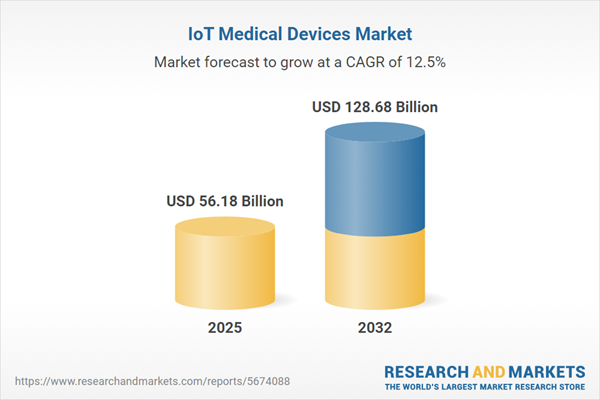Speak directly to the analyst to clarify any post sales queries you may have.
The IoT Medical Devices Market is transforming global healthcare by integrating advanced connectivity, data analytics, and smart technologies into patient care devices. This evolution is enabling healthcare organizations to streamline operations, improve patient monitoring, and foster more targeted outcomes.
Market Snapshot: IoT Medical Devices Market Growth
The IoT Medical Devices Market grew from USD 50.16 billion in 2024 to USD 56.18 billion in 2025. It is projected to expand at a CAGR of 12.49%, reaching USD 128.68 billion by 2032. Strong technological momentum, patient-centric care models, and connectivity advancements underpin sustained sector expansion globally, with widespread adoption continuing across medical environments.
Scope & Segmentation
- Device Types: Implantable devices (cardiac implants, neurostimulators); vital signs monitoring devices (blood pressure monitors, ECG/EKG monitors, glucose monitors, oximeters); wearable devices (health monitoring, therapeutic wearables, wellness and fitness wearables).
- Connectivity Technology: Bluetooth, cellular, near field communication (NFC), RFID, Wi-Fi.
- Applications: Asset tracking, chronic disease management, medication management, patient monitoring (remote and vital signs), telemedicine.
- End Users: Ambulatory surgical centers, clinics, home healthcare, hospitals.
- Deployment Modes: Cloud-based and on-premise platforms.
- Regions Covered: Americas (North America, Latin America), Europe, Middle East & Africa (EMEA), Asia-Pacific.
- Featured Companies: Abbott Laboratories, AliveCor Inc., B. Braun SE, Baxter International Inc., Becton Dickinson and Company, BioSerenity, Boston Scientific Corporation, Current Health Ltd., DexCom Inc., F. Hoffmann-La Roche Ltd, Garmin Ltd., General Electric Company, Huawei Technologies Co. Ltd., Johnson & Johnson, Koninklijke Philips N.V., Masimo Corporation, Medline Industries Inc., Medtronic plc, Mindray Medical International Limited, Omron Corporation, Oura Health Ltd., Radiometer Medical ApS, Siemens Healthineers AG, Strados Labs, Stryker Corporation.
Key Takeaways
- Clinical outcomes are enhanced through the integration of connected sensors, wearable devices, and real-time analytics, supporting data-driven healthcare delivery.
- Technological trends such as artificial intelligence, edge computing, and 5G networking are enabling predictive diagnostics and reduced latency, with cross-industry collaboration enhancing device security.
- Regulatory frameworks are evolving to balance innovation and patient safety; interoperability standards are fostering seamless data exchange and efficient clinical workflows.
- Adoption drivers vary by region: established infrastructure and reimbursement boost the Americas, regulatory harmonization supports the EMEA, while rapid urbanization and digital strategies fuel Asia-Pacific growth.
- Healthcare organizations and device manufacturers are aligning their business models to prioritize cybersecurity, end-user experience, and robust supply chains.
Tariff Impact: Navigating Tariff-Induced Supply Chain Dynamics
Recent U.S. tariffs have disrupted component sourcing and assembly, prompting manufacturers to diversify suppliers and consider nearshoring. Strategic partnerships and joint ventures have emerged to localize high-precision manufacturing and mitigate future uncertainty. Healthcare providers are reassessing procurement practices to manage total cost of ownership in light of these changes.
Methodology & Data Sources
This analysis is built on a robust blend of primary interviews with industry leaders, clinical practitioners, and technology specialists, complemented by secondary research from peer-reviewed journals and regulatory filings. Rigorous validation integrates macroeconomic insights with detailed device-level modelling, ensuring credible and actionable intelligence for senior decision-makers.
Why This Report Matters
- Enables organizations to benchmark strategies against industry leaders and adapt to evolving market, regulatory, and technology drivers.
- Identifies regional and segment-specific growth opportunities, supporting targeted market entry and investment planning.
- Equips stakeholders with trusted, data-driven insights for risk mitigation, operational resilience, and sustainable expansion in connected healthcare.
Conclusion
Strategic investments in IoT medical devices are redefining clinical care, driving operational efficiency, and expanding access worldwide. By leveraging these insights, organizations can proactively navigate sector challenges and capitalize on next-generation healthcare connectivity.
Additional Product Information:
- Purchase of this report includes 1 year online access with quarterly updates.
- This report can be updated on request. Please contact our Customer Experience team using the Ask a Question widget on our website.
Table of Contents
3. Executive Summary
4. Market Overview
7. Cumulative Impact of Artificial Intelligence 2025
Companies Mentioned
The companies profiled in this IoT Medical Devices market report include:- Abbott Laboratories
- AliveCor, Inc.
- B. Braun SE
- Baxter International Inc.
- Becton Dickinson and Company
- BioSerenity
- Boston Scientific Corporation
- Current Health Ltd.
- DexCom, Inc.
- F. Hoffmann-La Roche Ltd
- Garmin Ltd.
- General Electric Company
- Huawei Technologies Co., Ltd.
- Johnson & Johnson
- Koninklijke Philips N.V.
- Masimo Corporation
- Medline Industries, Inc.
- Medtronic plc
- Mindray Medical International Limited
- Omron Corporation
- Oura Health Ltd.
- Radiometer Medical ApS
- Siemens Healthineers AG
- Strados Labs
- Stryker Corporation
Table Information
| Report Attribute | Details |
|---|---|
| No. of Pages | 185 |
| Published | November 2025 |
| Forecast Period | 2025 - 2032 |
| Estimated Market Value ( USD | $ 56.18 Billion |
| Forecasted Market Value ( USD | $ 128.68 Billion |
| Compound Annual Growth Rate | 12.4% |
| Regions Covered | Global |
| No. of Companies Mentioned | 26 |









